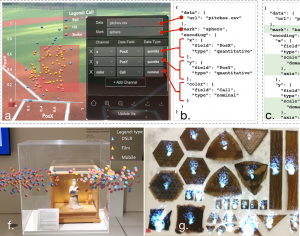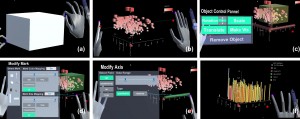
DXR: A Toolkit for Building Immersive Data Visualizations
This paper presents DXR, a toolkit for building immersive data visualizations based on the Unity development platform. Over the past years, immersive data visualizations in augmented and virtual reality (AR, VR) have been emerging as a promising medium for data sense-making beyond the desktop. However, creating immersive visualizations remains challenging, and often require
complex low-level programming and tedious manual encoding of data attributes to geometric and visual properties. These can hinder the iterative idea-to-prototype process, especially for developers without experience in 3D graphics, AR, and VR programming. With DXR, developers can efficiently specify visualization designs using a concise declarative visualization grammar inspired by Vega-Lite. DXR further provides a GUI for easy and quick edits and previews of visualization designs in-situ, i.e., while immersed in the virtual world. DXR also provides reusable templates and customizable graphical marks, enabling unique and engaging visualizations. We demonstrate the flexibility of DXR through several examples spanning a wide range of applications.

Gadget Arms: Interactive Data Visualization using Hand Gesture in Extended Reality
Extended Reality (XR), such as virtual and augmented reality, has huge potential for immersive data visualization and analysis. In XR, users can interact with data and other users realistically by navigating the shared virtual space, allowing for more intuitive data analysis. However, creating a visualization in XR also poses a challenge because complicated, low-level programming is required, which hinders broad adaptation in visual analytics. This paper proposes an interactive visualization authoring tool based on hand gesture for immersive data visualization—Gadget Arms. The proposed system provides a novel user interaction to create and place visualization in the 3D virtual world. This simple, but intuitive, user interaction enables user designs the entire visualization space in the XR without using a host computer and low-level programming. Our user study also confirmed that the proposed user interaction significantly improves the usability of the visualization authoring tool.



